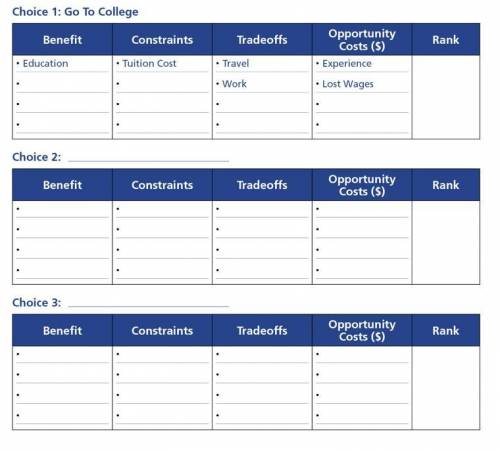
Business, 21.04.2021 21:50 ivanlopez9852
Student Resource 3.1 Independent Activity: Opportunity Costs and Trade-offs in Real Life Complete the form below by listing two things (Choice 2 and Choice 3) that you could do after you graduate from high school. Going to college is already included as one choice. Write the benefits (utility), constraints, and trade-offs of each choice. These can be both quantitative (the cost of school tuition) and qualitative (it’s hard to put a price tag on the experience of travel). To help you complete the assignment, get input from friends and family members who have already made the same choice. You also might conduct an Internet search using the search term “value of college education.” Finally, rank your choices from 1 to 3 in the order that you are most likely to choose them. Note that these rankings are not set in stone and may change over time.


Answers: 2


Other questions on the subject: Business

Business, 21.06.2019 20:30, christinachavez081
The federal act which provided over $7 billion to the epa to protect and promote "green" jobs and a healthier environment is the - national environmental policy act. - resource recovery act.- resource conservation and recovery act.- american recovery and reinvestment act. - clean air act.
Answers: 1

Business, 21.06.2019 21:20, ninilizovtskt
“wonderful! not only did our salespeople do a good job in meeting the sales budget this year, but our production people did a good job in controlling costs as well,” said kim clark, president of martell company. “our $11,150 overall manufacturing cost variance is only 3% of the $1,536,000 standard cost of products made during the year. that’s well within the 3% parameter set by management for acceptable variances. it looks like everyone will be in line for a bonus this year.” the company produces and sells a single product. the standard cost card for the product follows: standard cost card—per unit direct materials, 4.00 feet at $4.00 per foot $ 16.00 direct labor, 1.1 direct labor-hours at $13 per direct labor-hour 14.30 variable overhead, 1.1 direct labor-hours at $2.40 per direct labor-hour 2.64 fixed overhead, 1.1 direct labor-hours at $6.50 per direct labor-hour 7.15 standard cost per unit $ 40.09the following additional information is available for the year just completed: a. the company manufactured 20,000 units of product during the year. b. a total of 77,000 feet of material was purchased during the year at a cost of $4.25 per foot. all of this material was used to manufacture the 20,000 units. there were no beginning or ending inventories for the year. c. the company worked 24,000 direct labor-hours during the year at a direct labor cost of $12.50 per hour. d. overhead is applied to products on the basis of standard direct labor-hours. data relating to manufacturing overhead costs follow: denominator activity level (direct labor-hours) 19,000 budgeted fixed overhead costs $ 123,500 actual variable overhead costs incurred $ 64,800 actual fixed overhead costs incurred $ 120,900required: 1. compute the materials price and quantity variances for the year. (round standard price and actual price to 2 decimal places. indicate the effect of each variance by selecting "f" for favorable, "u" for unfavorable, and "none" for no effect (i. e., zero 2. compute the labor rate and efficiency variances for the year. (round standard rate and actual rate to 2 decimal places. indicate the effect of each variance by selecting "f" for favorable, "u" for unfavorable, and "none" for no effect (i. e., zero 3. for manufacturing overhead compute: a. the variable overhead rate and efficiency variances for the year. (round standard rate and actual rate to 2 decimal places. indicate the effect of each variance by selecting "f" for favorable, "u" for unfavorable, and "none" for no effect (i. e., zero b. the fixed overhead budget and volume variances for the year. (indicate the effect of each variance by selecting "f" for favorable, "u" for unfavorable, and "none" for no effect (i. e., zero
Answers: 2

Business, 22.06.2019 06:00, esnyderquintero
Cash flow is often a problem for small businesses. how can an entrepreneur increase cash flow? a) locate lower-priced suppliers. b) forego sending in estimated tax payments to the irs c) shorten the terms on a bank loan to pay it off more quickly d) sell more low-margin items.
Answers: 1

Business, 22.06.2019 15:40, Fire8615
Colter steel has $5,550,000 in assets. temporary current assets $ 3,100,000 permanent current assets 1,605,000 fixed assets 845,000 total assets $ 5,550,000 assume the term structure of interest rates becomes inverted, with short-term rates going to 10 percent and long-term rates 2 percentage points lower than short-term rates. earnings before interest and taxes are $1,170,000. the tax rate is 40 percent earnings after taxes = ?
Answers: 1
You know the right answer?
Student Resource 3.1 Independent Activity: Opportunity Costs and Trade-offs in Real Life
Complete...
Questions in other subjects:

English, 29.11.2020 14:00

Social Studies, 29.11.2020 14:00

Mathematics, 29.11.2020 14:00

Physics, 29.11.2020 14:00

Social Studies, 29.11.2020 14:00




Geography, 29.11.2020 14:00



